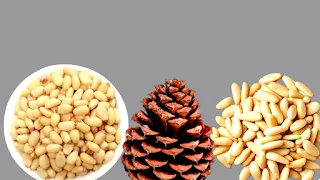Pine
Nut (Chilgoza)
Pine
nuts, commonly referred to as pignoli or chilgoza, are the pine tree's edible
seeds (family Pinaceae, genus Pinus). Only 29 species, 20 of which are sold
locally or internationally, produce edible nuts, according to the Food and
Agriculture Organization. due to the fact that their seeds are large enough to
be valuable for collecting; while the seeds of other pines are edible, they are
too little to be of significant value as food for humans.
In
India Pine nuts are called as Chilgoza (In Hindi चिलगोजा).
Species and Geographical Expansion
Particularly
in Asia, two species are heavily harvested: chilgoza pine (Pinus gerardiana) in
the western Himalaya and the Korean pine (Pinus koraiensis) in northeast Asia,
which is the most significant species in international trade. Chinese white
pine (Pinus armandii), Siberian dwarf pine (Pinus sibirica), Siberian dwarf
pine (Pinus pumila), and lacebark pine (Pinus bungeana) are the other four
species that are employed to a lesser extent. Over 10,000 tonnes of
forest-grown nuts are produced in Mongolia each year, which is the
second-largest producer of Pinus sibirica nuts after Russia. The majority of
the produce is sent to China for export. After China and Korea, Afghanistan is
a significant producer of pine nuts.
The
stone pine (Pinus pinea), which has been grown for its nuts for more than 5,000
years, is the source of the majority of pine nuts produced in Europe. For far
longer, pine nuts have been taken from untamed trees. A very small amount of
Swiss pine (Pinus cembra) is also used.
Three
of the pinyon pines—the Colorado pinyon (Pinus edulis), single-leaf pinyon
(Pinus monophylla), and Mexican pinyon—are the predominant species in North
America (Pinus cembroides). Gray pine (Pinus sabineana), Coulter pine (Pinus coulteri),
Torrey pine (Pinus torreyana), sugar pine (Pinus lambertiana), and Parry pinyon
are among the other eight pinyon species that are employed to some extent
(Pinus quadrifolia). Here, the nuts themselves are referred to as pión (plural:
piones), the Spanish name for the pinyon pine.
Pine
nuts are mostly harvested by Native American and Hispanic populations in the
United States, particularly in the West and Southwest. In particular, the
Uto-Aztecan Shoshone, Paiute, Navajo, Pueblo, Hopi, Washoe, and Hispanos of New
Mexico harvest pine nuts. Native Americans have the legal right to harvest pine
nuts under particular treaties and Nevadan regulations, and the word
"pion" is protected for usage with pine nuts from specific native New
Mexican pine species.
Description and Physical Characteristics
They
have a hard seed coat when first removed from the pine cone, which can be thin
or thick depending on the species. The embryo (sporophyte) in the centre stores
the food. Despite being a nut in the culinary sense, pine nuts are actually
seeds since they are a gymnosperm and do not have an external carpel (fruit).
Before
eating the pine nut, the shell must be removed. Unshelled pine nuts can be
stored for a long time provided they are kept dry and cold (between 5 and 2
°C); but, in warm, humid environments, shelled nuts and unshelled nuts both
quickly degrade and get rancid. Commercially accessible shelled pine nuts can
have poor flavour and may even be rotten when purchased due to poor storage
practises. As a result, pine nuts are frequently frozen to maintain their
flavour.
By
being longer than they are wide, European pine nuts can be identified from
Asian ones; Asian pine nuts are stubbier and resemble long kernels of corn. The
American pion nut is renowned for its size and simplicity in shelling. Due to
the trading post system and the Navajo people who used the nuts for trade, P.
edulis, the hard shell of New Mexico and Colorado, rose to popularity in the
United States. Immigrants introduced the Italian pine nut (P. pinea) to the
country, and in the early 1930s, when there were abundant supplies of
affordable American pine nuts, it quickly became a popular treat along the East
Coast.
Pine Nut Nutrition
Pine nuts contains 2% water, 13% carbs, 14% protein, and 68% fat when dried for food. Dried pine nuts are a rich source (20% or more of the Daily Value, DV) of many micronutrients, including manganese (419% DV), phosphorus (82% DV), magnesium (71% DV), zinc (67% DV), copper (65% DV), vitamin E (62% DV), vitamin K (51% DV), and the B vitamins thiamin and niacin (29-35% DV) among others. This amounts to 2,815 kilojoules.
Pine Nut (Chilgoza) Nutrition Facts
|
Pine Nut Nutritional
value per 100 g |
|
|
|
|
|
Energy |
673 kcal |
|
Carbohydrate |
13.1 g |
|
Dietary fiber |
3.7 g |
|
Protein |
13.7 g |
|
FAT (Total) Monounsaturated Polyunsaturated |
68.4 g |
|
18.7 g |
|
|
3.1 g |
|
|
Vitamins Quantity %DV† |
|
|
Vitamin A |
0% |
|
Thiamine (B1) |
35% |
|
Riboflavin (B2) |
17% |
|
Niacin (B3 |
29% |
|
Pantothenic acid (B5) |
6% |
|
Vitamin B6 |
8% |
|
Foliate (B9) |
9% |
|
Vitamin C |
1% |
|
Vitamin E |
62% |
|
Vitamin K |
51% |
|
Minerals Quantity %DV† |
|
|
Calcium |
2% |
|
Copper |
65% |
|
Iron |
42% |
|
Magnesium |
71% |
|
Manganese |
419% |
|
Phosphorus |
82% |
|
Potassium |
13% |
|
Zinc |
67% |
|
Selenium |
1% |
Culinary uses
Since
the Paleolithic era, people in Europe and Asia have consumed pine nuts. They
are typically included in bread recipes or added to dishes with meat, fish,
salads, and vegetables.
They
are a key ingredient in Italian pesto sauce, which has become increasingly
popular since the 1990s. The rise in popularity of this sauce has increased the
visibility of the nut in America, particularly on the West Coast. In the US,
they are frequently called pignoli, but in Italy the word pignolo is actually
much more commonly used to describe a fussy, overly fastidious, or extremely
meticulous person. Torta della Nonna, which translates to "granny's
cake," is a general name for an Italian dish that, in most families,
refers to a traditional family recipe for any kind of cake. However, it is
frequently used to refer to a tart or pie that is filled with custard, topped
with pine nuts, and optionally dusted with icing sugar. Pignoli cookies are an
Italian American speciality treat that are created with almond flour to
resemble a macaroon-like dough and are then coated with pine nuts. In Italy,
these treats are known as biscotti ai pinoli.
Small marzipan balls wrapped in pine nuts, painted with egg, and heated just enough to set the egg are called "Panellets" in Catalonia. The salade landaise from southwest France also includes pine nuts. The Nevada, or Great Basin, pine nut is advertised for its huge size, sweet flavour, and simplicity of peeling. It has a pleasant fruity flavour. Pine nuts are another common ingredient in Middle Eastern food, and they may be found in a broad variety of foods like kibbeh, sambusak, and fatayer as well as desserts like baklava. The traditional source of pine nuts in Europe and the Middle East is Pinus pinea (stone pine).
Uncertain
- discuss Their more slender shape and homogeneous flesh make them easy to
differentiate from Asian pine nuts. Asian pine nuts are also frequently
utilised due to the lower cost, particularly in less expensive dishes. Thiamine
(vitamin B1) and protein are both found in pine nuts.
A
specialty of the southwest United States, particularly New Mexico, pine nut
coffee, also known as pión (Spanish for pine nut), is typically a dark roast
coffee with a rich, nutty flavour. Roasted and lightly salted pine nuts are
frequently sold on the side of the road in cities throughout New Mexico to be
used for this purpose as well as a snack. Adding pine nut oil to food adds
flavour.
Health Benefits of Pine Nuts
Pine
Nuts are very rich in Amino acids, vitamin E, iron, magnesium, antioxidants, and
zinc which are essential for better health. Pine nuts are really versatile, and
you can use them for anything. They are also a fantastic gluten-free choice.
Although pricey, pine nuts are a worthwhile addition to your diet thanks to
their wealth of nutrients.
Pine
nuts are good for your heart, provide magnesium, which helps to stabilise your
mood, regulate your blood sugar, and improve your vision. Additionally, the
appetite-suppressing properties of these nuts stop you from ingesting extra
calories, which results in weight gain. For people trying to lose weight, pine
nuts can be a wise choice. The sort of lipids that are frequently present in
seeds and nuts may be the cause of this advantage.
Other
significant health advantages of pine nuts include:
Heart Health
Pine
Punts rich nutrients content, including antioxidants that support and enhance
heart health, are found in pine nuts and may lessen the risk of cardiovascular
disease. A minimum of three servings of pine nuts or other tree nuts per week
may lower your risk of atrial fibrillation and heart failure. And consuming at
least one ounce of nuts every day may further reduce your risk of developing
heart disease.
Nuts'
unsaturated fats work to increase HDL, or "good" cholesterol, while
lowering LDL, or "bad" cholesterol. Omega-3 fatty acids may help
avoid blood clotting and arrhythmias, a disease in which your heart beats
excessively quickly or slowly.
Diabetes Management
Because
of the combination of lipids, fibre, and protein found in pine nuts and other
seeds and nuts, they may help maintain stable blood sugar levels. Pine nuts'
also found rich in magnesium which may enhance insulin's capacity to absorb
glucose.
Brain Health
Pine
nuts contain omega-3 fatty acids, which can support brain cell growth and repair.
Omega-3 fatty acids have been linked in studies to better memory function and
blood flow to the brain. In addition to lowering cellular stress and
inflammation in the brain, the antioxidants in pine nuts may also aid boost
general cognition and minimise the risk of dementia.
Weight Management
Protein,
fibre, and healthy fats found in pine nuts work together to help you feel
filled for longer. Despite having a high caloric content, nuts don't cause
weight gain and increase feelings of fullness. Nuts are a healthier snack
option than more processed meals, which may aid in satiety. Pine nut fatty
acids have also been linked to improved weight management.
Pine Nut (Chilgoza Price)
The current price of pine nuts (Chilgoza) in 2022 is range between Indian rupees 2500-6000 per kilogram, depending on quality and size.










0 Comments